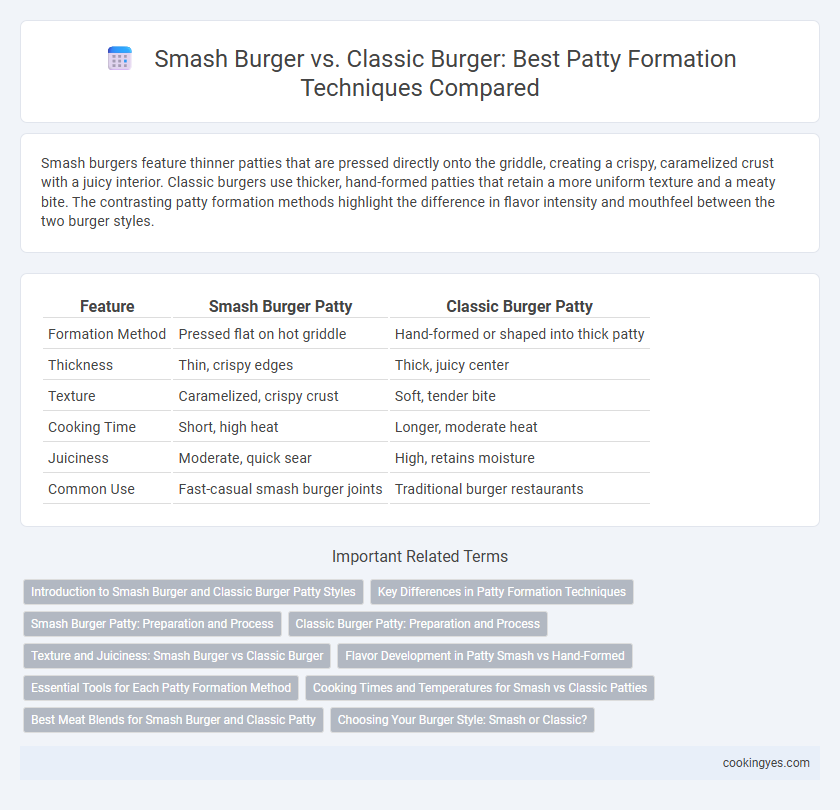Smash burgers feature thinner patties that are pressed directly onto the griddle, creating a crispy, caramelized crust with a juicy interior. Classic burgers use thicker, hand-formed patties that retain a more uniform texture and a meaty bite. The contrasting patty formation methods highlight the difference in flavor intensity and mouthfeel between the two burger styles.
Table of Comparison
| Feature | Smash Burger Patty | Classic Burger Patty |
|---|---|---|
| Formation Method | Pressed flat on hot griddle | Hand-formed or shaped into thick patty |
| Thickness | Thin, crispy edges | Thick, juicy center |
| Texture | Caramelized, crispy crust | Soft, tender bite |
| Cooking Time | Short, high heat | Longer, moderate heat |
| Juiciness | Moderate, quick sear | High, retains moisture |
| Common Use | Fast-casual smash burger joints | Traditional burger restaurants |
Introduction to Smash Burger and Classic Burger Patty Styles
Smash burgers feature thin, flat patties created by pressing a ball of ground beef onto a hot griddle, resulting in a crispy, caramelized crust and juicy interior. Classic burgers use thicker, hand-formed patties that cook evenly, retaining a tender and juicy texture with a bolder beef flavor. Both styles emphasize high-quality ground beef but deliver distinct textures and taste profiles due to their unique formation methods.
Key Differences in Patty Formation Techniques
Smash burgers feature thin patties formed by pressing a ball of ground beef onto a hot griddle, maximizing surface contact for a crispy, caramelized crust. Classic burgers use thicker, hand-formed patties that retain juiciness through slower cooking methods and less edge-to-surface exposure. The key difference lies in the formation technique: smash burgers prioritize texture and crust development, while classic patties focus on a tender, juicy interior.
Smash Burger Patty: Preparation and Process
Smash burger patty preparation involves pressing a ball of ground beef thinly onto a hot griddle using a heavy spatula or specialized smasher, creating a crispy, caramelized crust through the Maillard reaction. This quick cooking process locks in juices while producing a seared exterior that contrasts with the tender interior, differentiating it from the thicker, hand-formed classic burger patty. The technique enhances flavor concentration and texture, making the smash burger distinctive in patty formation and taste profile.
Classic Burger Patty: Preparation and Process
Classic burger patties are typically formed by hand, using ground beef with a fat content between 15-20% to ensure juiciness and flavor. The process involves gently shaping the meat into uniform, round discs without overworking to maintain tenderness and avoid a dense texture. Patties are often seasoned simply with salt and pepper before cooking to highlight the natural beef flavor.
Texture and Juiciness: Smash Burger vs Classic Burger
Smash burgers feature patties that are pressed thinly on a hot griddle, creating a crispy, caramelized crust that enhances texture and locks in juices for a juicy bite. Classic burgers, with thicker, hand-formed patties, provide a tender and more uniform texture but often have a slightly drier interior compared to smash burgers. The smash technique maximizes surface area caramelization, resulting in a richer umami flavor and moisture retention that distinguishes it from the traditional classic burger patty.
Flavor Development in Patty Smash vs Hand-Formed
Smash burgers create a thinner, crispier crust by pressing the patty directly onto a hot griddle, enhancing Maillard reactions that intensify savory, caramelized flavors. Hand-formed classic burgers retain more juiciness inside but develop less surface crust, resulting in a milder, beef-forward taste profile. The contrast in patty formation techniques significantly impacts flavor development, with smash burgers offering a more robust, textured flavor experience.
Essential Tools for Each Patty Formation Method
Smash burgers require a heavy, flat spatula or press to effectively smash the patty thin and create a crispy crust, while classic burgers benefit from a gentler seasoning and shaping method using hands or a burger press for uniform thickness. Cast iron skillets or flat griddles are essential for both methods, ensuring even heat distribution and optimal sear quality. Digital thermometers enhance precision cooking by monitoring patty internal temperature, crucial for both smash and classic burger patty formations.
Cooking Times and Temperatures for Smash vs Classic Patties
Smash burger patties cook rapidly at higher heat, typically around 400-450degF, searing in 2-3 minutes per side to create a crispy, caramelized crust. Classic burger patties are thicker and cook at moderate temperatures of 350-375degF, requiring 4-5 minutes per side for even doneness and a juicier interior. The thinner smash patties prioritize fast cooking and maximum surface browning, while classic patties emphasize slower heat penetration for tenderness.
Best Meat Blends for Smash Burger and Classic Patty
Smash burgers benefit from finely ground meat blends with higher fat content, typically 80/20 chuck and brisket, to ensure a crispy, flavorful crust when pressed thin on a hot griddle. Classic patties favor coarser grind blends like a mix of chuck, sirloin, and short rib, offering a juicier, thicker texture that holds up well on grills or griddles. Selecting the right meat blend enhances texture and flavor, with smash burgers relying on fat for caramelization and classic burgers on balanced meat cuts for robustness.
Choosing Your Burger Style: Smash or Classic?
Smash burgers feature thin, crispy patties created by pressing the meat onto a hot griddle, maximizing caramelization and delivering a crunchy texture with rich beef flavor. Classic burgers have thicker, juicier patties formed by gently shaping the ground beef, retaining moisture and a tender bite. Choosing between smash and classic depends on preference for texture and flavor intensity, with smash offers bold charred edges and classic provides a hearty, succulent experience.
Smash burger vs Classic burger for patty formation Infographic

 cookingyes.com
cookingyes.com